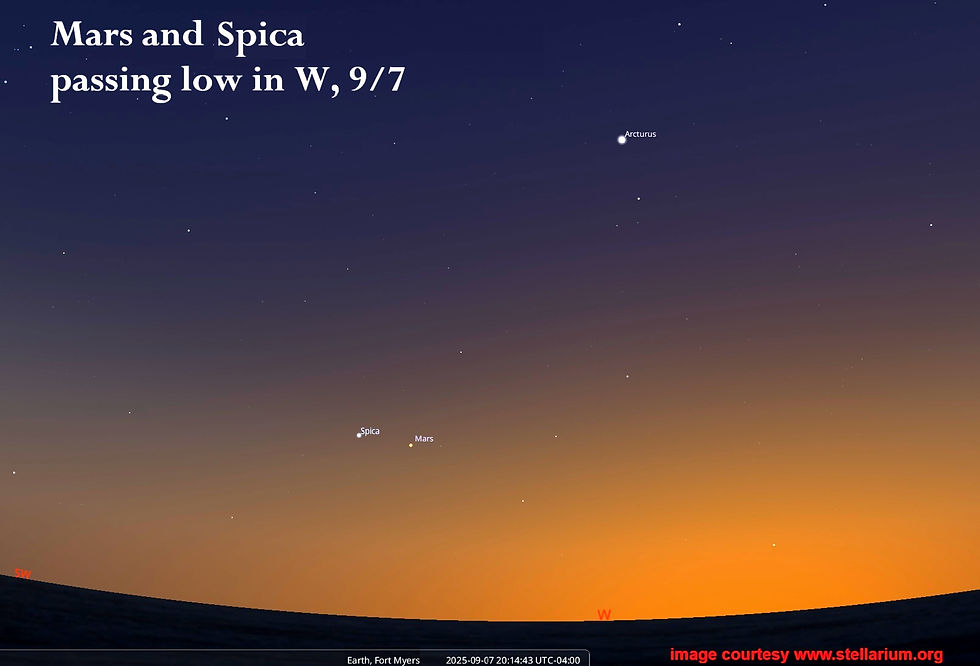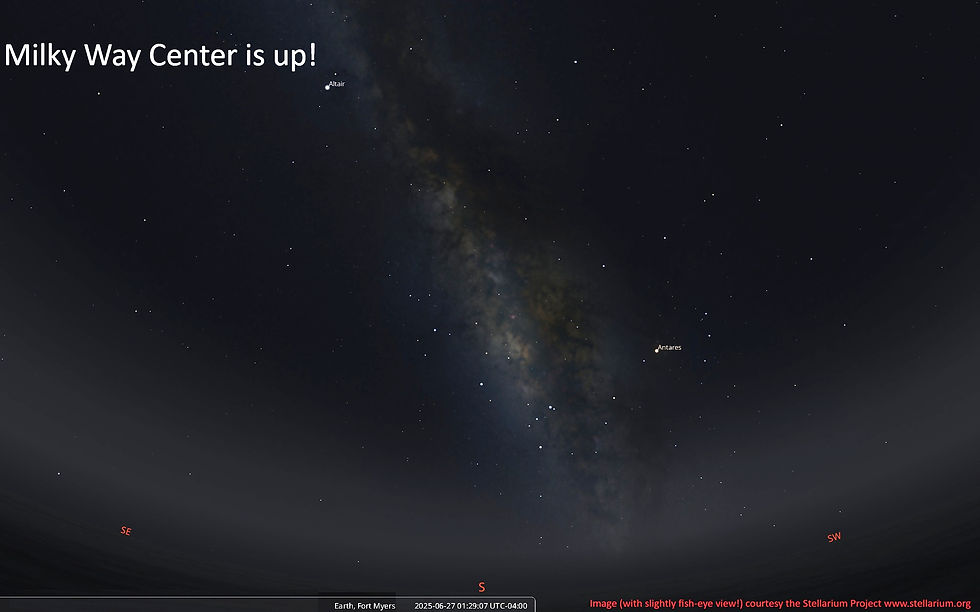What's Up in SW FL Skies: December Skies, With Planets, Meteors and Constellations this month
- heather92475
- Dec 1, 2024
- 4 min read
Updated: Dec 7, 2024

Moon Phases December 2024 (Eastern Time)
New 1st Quarter Full 3rd Quarter
1 8 15 22
Meteors: The Geminid meteor shower is sometimes called the best meteor shower of the year, although August's Perseids also have that honor. The Geminids shower should peak on December 13th this year, with up to 120 meteors per hour being possible under ideal conditions (dark skies out in the countryside and not a lot of moonlight). Unfortunately, as you can see from the Moon Phases, the moon will be waxing gibbous on December 13, just two days from full.
The Geminids shower is not a narrow peak, you will see some Geminid meteors latenight between November 19 and December 24, but the night of the peak will have the highest rates of meteors. The meteors appear to radiate from the direction of the constellation Gemini (just north of Orion), but will be visible crossing anywhere in the sky. To do a "meteor watch" people sometimes set out lawn chairs facing outward in a circle with the heads together so they cover every direction together :-) The asteroid known as 3200 Phaethon (sometimes called a "rock comet") is responsible for the Geminid meteor shower: every year when we get to the same spot in Earth's orbit we intersect Phaethon's orbit and encounter tiny pieces of debris strewn along that orbit, kind of like intercepting bugs on a windscreen as we travel around the Sun! Best time to see meteor showers is after midnight - Gemini will be highest about 2 am - but you can still see some Geminids from about 10 pm on, although the moonlight will make it a little more challenging than usual.
Planets: Sunset, Night and Dawn
The brightest pointlike feature in our early evening sky is not a star, it's the brilliant planet Venus! Our "Morning star/Evening star which is really a planet" dominates the early evening southwestern sky all month long, low in the southwest after sunset. It just gets brighter and brighter all month long! But it also will start getting a little closer to the setting sun, from Earth's point of view.
At the beginning of the month, the planet Saturn is already well above the southern horizon once it's fully dark out. The bright star "below" Saturn is the lovely southern hemisphere star, Fomalhaut.
At the start of the month, Jupiter will be in the eastern sky just after sunset and then about 4 hours later Mars will follow it. Jupiter reaches opposition on December 7, meaning it's directly opposite the Sun in Earth's skies, so it's at its brightest for the year -- and visible all night long. Because the Sun is setting south of west, Jupiter's rising in the north of east as darkness falls, among the stars of the constellation Taurus. Mid-month, around December 14, Jupiter will stand between the nearly full Moon and Taurus's brightest star, orange-colored Aldebaran (the "red eye of the Bull").
Mars rises a few hours after Jupiter, but keep an eye out for its colorful presence! On December 17th, the waning gibbous Moon will make a lovely sight beside Mars in our eastern sky around 9:30 pm.

The Stars of Summer Still Transitioning to the Stars of Winter: Summer Triangle to Winter Hexagon
On any evening in December, looking westward just after sunset, you'll be able to spot the famous Summer Triangle, but it will gradually get a little closer to the western horizon each evening. Made of the brightest star in each of three constellations, it's an easy-to-see large triangle in our summer-to-late-fall skies - but we can even see it in December if we look as soon as the Sun has set.
The three bright stars are (from northwest to uppermost to west): Vega in the constellation Lyra (the Lyre), Deneb in the constellation Cygnus (the Swan), and Altair in the constellation Aquila (the Eagle). Each star will set a few minutes earlier each day, so the Summer Triangle will start each night just a bit farther to the west than it was at the same time the night before. How strange to be able to see the Summer Triangle at the start of winter!
However, looking east, you will see the bright stars of winter above your eastern horizon, with the constellations Orion (with bright stars Betelgeuse and Rigel) and Taurus (with brilliant Aldebaran and temporary visitor Jupiter), followed by Orion's two famous hunting dogs, the bright "dog stars," Sirius (in Canis Major) and Procyon (in Canis Minor), plus Castor and Pollux in Gemini, and Capella - the bright star in Auriga. Six bright winter stars surround Betelgeuse [pronounced BEEtle-juice] in what is nicknamed the Winter Hexagon. These will all be up by 9:30 pm at the start of December - and 4 minutes earlier each night that passes! But they are better seen a little later, when they are farther above the horizon, of course.
Planetarium
Each day we are open, we show two different planetarium shows, and odd day shows are different from even-day shows, so there are four different shows each month that alternate. Schedule and show descriptions can be accessed by clicking on "Simple Calendar" when you follow our Events link. On Sundays (the "Science Sundays" extra show), there's an additional "audience choice" show at 3:15, and typically on the First Sunday of each month we have a Sensory Sunday special show at 10:30 am, and most months we also have a Planetarium Premiere on the third Wednesday at 7 pm, so you have the potential to see ten different shows in the course of the month. The whole nature center, planetarium, butterfly aviary, raptor aviary and trails complex is open six days per week, closed Mondays. This month, Fri/Sat/Sun from December 5-29, there are also Holiday Lights and seasonal LASER SHOWS in the planetarium, so do check those out. Also, after mid-month, I will be moving as "Planetarium Director Emeritus" to a remote association with the planetarium (doing some technical work with videos and grant proposals), as our family is relocating across country. Our new Planetarium Supervisor will be Todd Sherman, who has been Planetarium Educator here for years, so he will be a familiar friendly face/voice to most of you already. Hoping to see you soon at the Center!
-- Heather Preston, Planetarium Director





In Sprunki, players can remix sounds and animations to craft their very own musical masterpiece in just a few clicks.
From hidden keys to daring escapes, Granny Game turns every move into a heart-pounding test of stealth and survival!